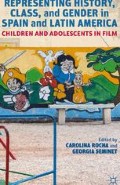Abstract
Socially motivated filmmaking involving issues of children and violence often oscillates uneasily between two opposing tendencies: the committed and the exploitative film. As Owain Jones claims, the depiction of violence by and against children is in itself a powerful and significant theme “because of the way society considers children as natural and vulnerable, the violence that they, and all, are exposed to is more visible” (201–2). One way in which films about children and youth violence might engage viewers politically and avoid the exploitative element is by bringing the adult spectator’s perception closer to the child’s subjective experience and worldview through the use of inner focalization. The focus of this essay shall be on the children, the violence directed against them or committed by them, and how the degree of voice and focalization they are allowed by the filmic style might either activate the audience’s deepest fears or elicit sympathy and understanding, perhaps even empathy.1 To explore these concerns I will examine two very different films that depict the lives of marginalized urban children and youth: Rodrigo D: No futuro 2 (Víctor Gaviria 1990) from Colombia and El Bola (Achero Mañas 2000) from Spain.3
Access this chapter
Tax calculation will be finalised at checkout
Purchases are for personal use only
Preview
Unable to display preview. Download preview PDF.
Works Cited
“Abject.” Merriam-Webster.com . Merriam-Webster, 2011. Web. 20 Apr. 2011.
Bal, Mieke. “Focalization.” Narratology. Ed. Susana Omega and José Angel García Landa. New York: Longman, 1996. 115–28.
—, ed. Major Issues in Narrative Theory. Vol. 1 of Narrative Theory. New York: Routledge, 2004.
—. Narratology: Introduction to the Theory of Narrative. 3rd ed. Toronto: University of Toronto P, 2007.
Begin, Paul. “When Victim Meets Voyeur: An Aesthetic of Confrontation in Hispanic Social Issue Cinema.” Hispanic Research Journal 9.3 (2008): 261–75.
Bola, El. Dir. Achero Mañas. Perf. Juan José Ballesta, Pablo Galán and Alberto Jiménez. Film Movement, 2003. Digital videodisc.
Driver, Alice, and Joshua Jennings Tweddell. “Cinematic Realism and the Restoration of Everyday Life: An Interview with Víctor Gaviria.” Arizona Journal of Hispanic Cultural Studies 12 (2008): 237–54.
Duno-Gottberg, Luis, and Forrest Hylton. “Huellas de lo real: Testimonio y Cine de la Delincuencia en Venezuela y Colombia.” Miadas al margen: Cine y subalternidad en América Latina y el Caribe. Ed. Luis Duno-Gottberg. Caracas: Fundación Cinemateca Nacional, 2008. 247–86.
Genette, Gérard. Narrative Discourse: An Essay in Method. Trans. Jane E. Lewin. Ithaca, NY: Cornell University Press, 1980.
Jones, Owain. “‘True Geography Quickly Forgotten, Giving Away to an Adult-Imagined Universe.’ Approaching the Otherness of Childhood.” Children’s Geographies 6.2 (May 2008): 195–212.
Lury, Karen. The Child in Film: Tears, Fears and Fairytales. London: Tauris, 2010.
—. “The Child in Film and Television.” Screen 46.3 (2005): 307–14.
Marx, Karl. Capital: A Critique of Political Economy. Vol. 1. Chicago: Charles H. Kerr and Company, 1909.
Margolin, Uri. “Focalization. Where Do We Go from Here?” Point of View, Perspective, Focalization: Modeling Mediation in Narrative. Ed. Peter Hühn, Wolf Schmid, and Jörg Schönert. Berlin; New York: Walter de Gruyter, 2009. 41–58.
Rodgers, Dennis. Youth Gangs and Violence in Latin America and the Caribbean: A Literature Survey. Washington, DC: World Bank, 1999. Web. 20 Apr. 2011. <http://www.ansarilawfirm.com/docs/Youth-Gangs-and-Violence-in-Latin-America.pdf>.
Rodrigo D: No futuro. Dir. Víctor Gaviria. Perf. Ramiro Meneses, Carlos Mario Restrepo, Jackson Idrian Gallego. Chicago: Facets Video, 2004. Digital videodisc.
Ruffinelli, Jorge. Víctor Gaviria: Los márgenes, al centro; las películas, las ideas sobre cine, la poesía, los ensayos, los relatos, las crónicas. Madrid: Casa de América, 2004.
Sokoloff, Naomi B. “Interpretation: Cynthia Ozick’s Cannibal Galaxy.” Prooftexts 6.3 (Sept. 1986): 239–57.
Suárez, Juana. “Rafagazos de imágenes: Jóvenes y violencia en relatos fílmicos de Medellín.” Bad Subjects 61 (Sept. 2002): n. pag. Web. 20 Apr. 2011. <http://bad.eserver.org/issues/2002/61/suarez.html>.
Triana-Toribio, Núria. Spanish National Cinema. London: Routledge, 2003.
Editor information
Copyright information
© 2012 Carolina Rocha and Georgia Seminet
About this chapter
Cite this chapter
Ledesma, E. (2012). Through “Their” Eyes. In: Rocha, C., Seminet, G. (eds) Representing History, Class, and Gender in Spain and Latin America. Palgrave Macmillan, New York. https://doi.org/10.1057/9781137030870_9
Download citation
DOI: https://doi.org/10.1057/9781137030870_9
Publisher Name: Palgrave Macmillan, New York
Print ISBN: 978-1-349-44061-0
Online ISBN: 978-1-137-03087-0
eBook Packages: Palgrave Media & Culture CollectionLiterature, Cultural and Media Studies (R0)

